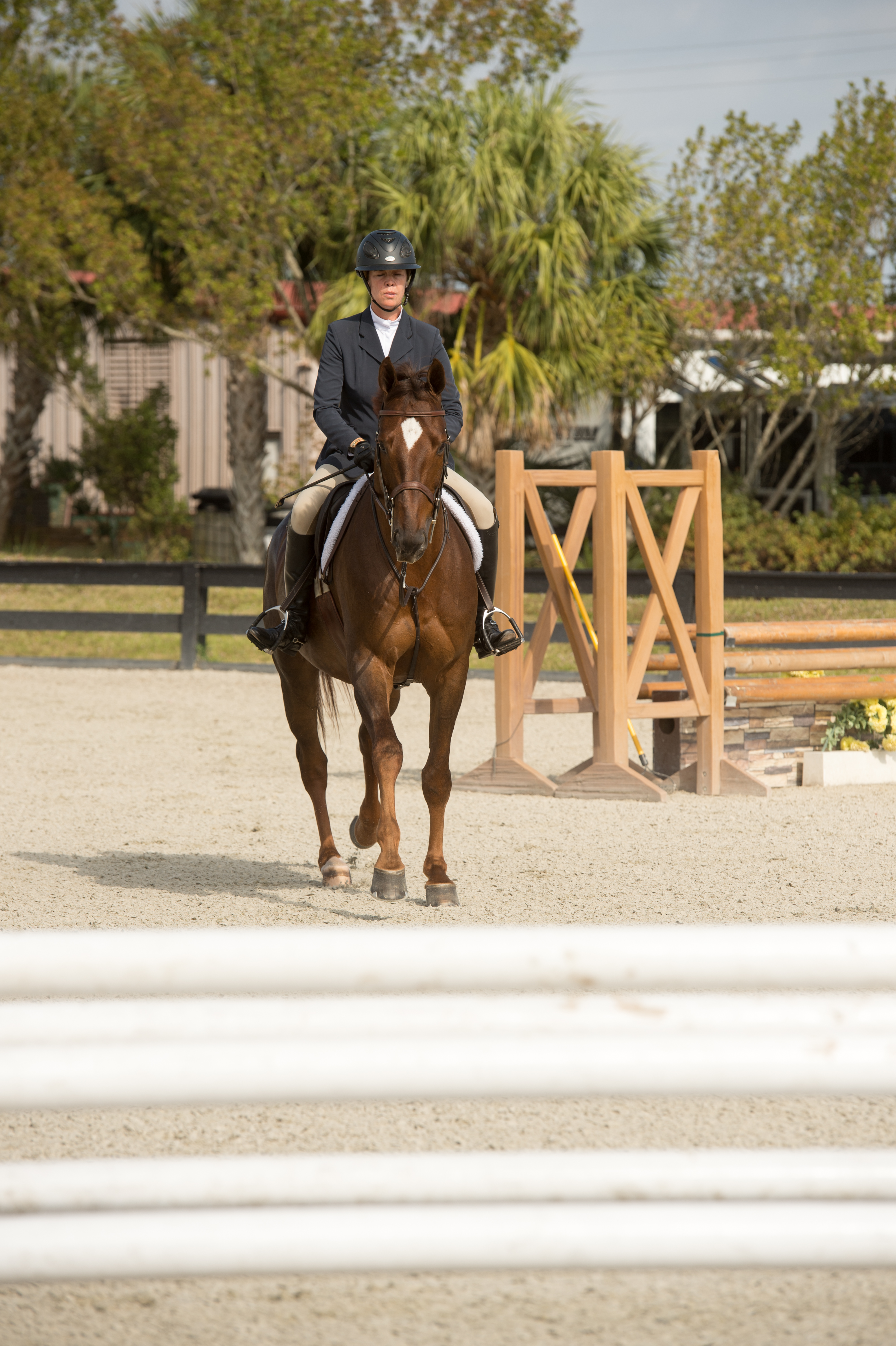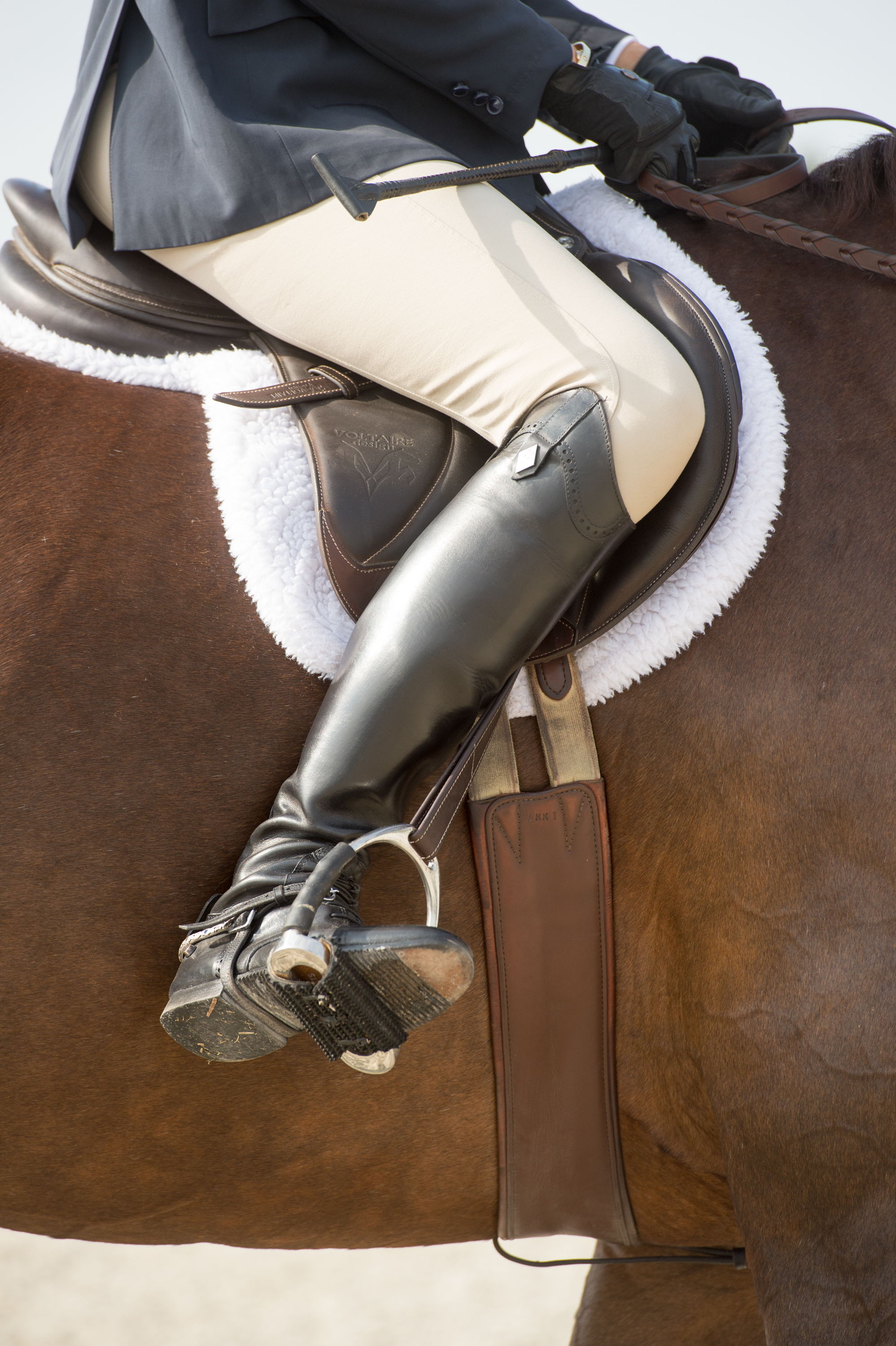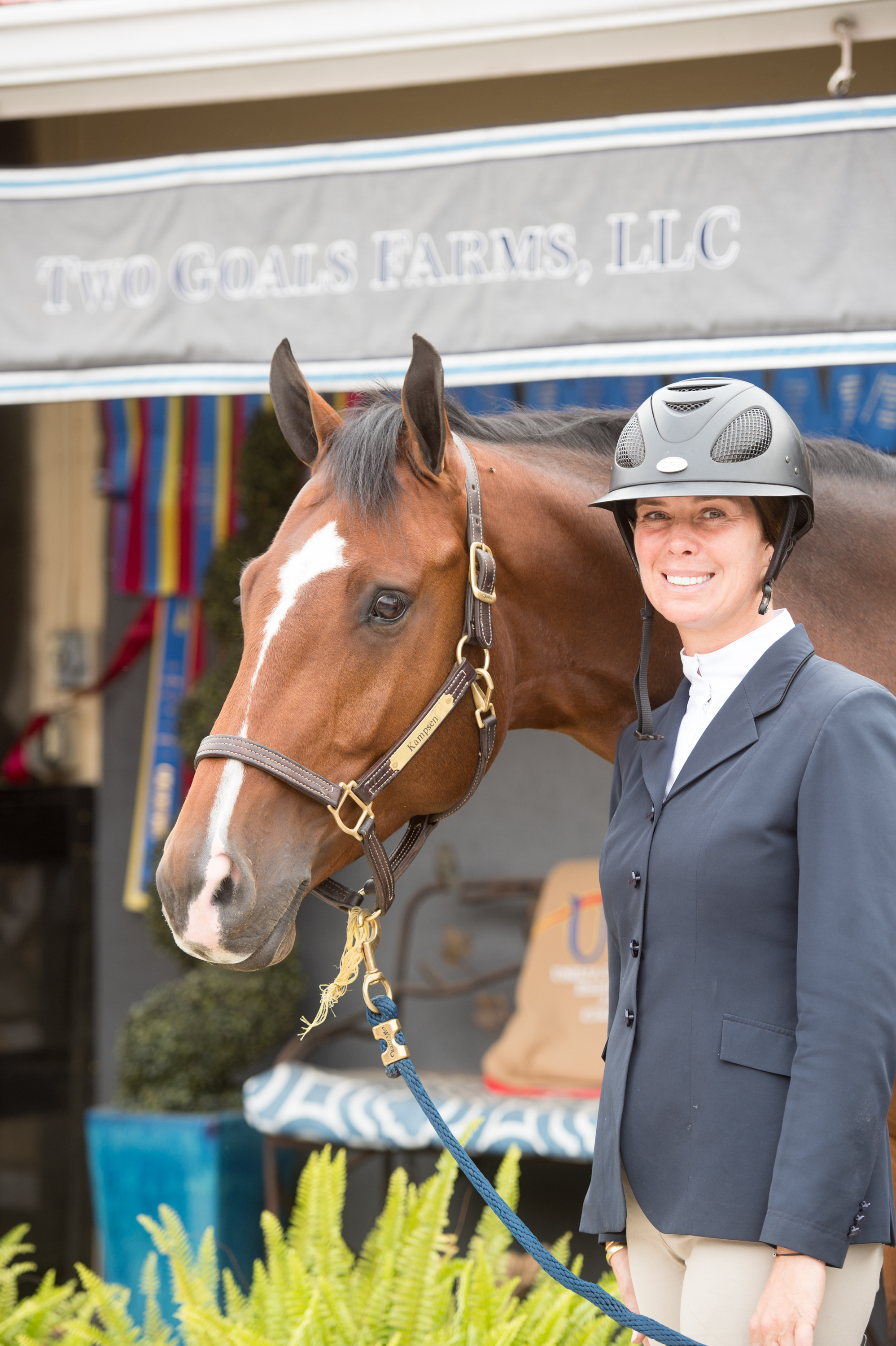Let’s face it: Things don’t always go to plan in the show ring. No matter how hard you practice at home, nothing replicates that environment when it’s just you and your horse in the ring and all eyes are on you. There’s no sure way of predicting how he’ll react to the jumps, how the lines will ride or what minor mistakes might snowball into bigger problems.
Many classes aren’t won or lost with the first mistake but rather with the second or third. How you react can often save you a place in the ribbons. At the very least, it will turn a potential disaster into a learning experience. In this article, I’ll explain how to develop essential skills for addressing mistakes quickly and effectively.
1. Fortify Your Flatwork
One of the most important tools we all rely on during competition is basic flatwork. Say your horse lands on the wrong lead at the end of a line. If your flatwork is solid, you can ride a few strides on the wrong lead, set up the change, then ask for it when the timing feels right. No frantic struggle to throw him onto the correct lead before the turn.
I’m a big fan of dressage lessons for anybody who jumps. In my training at home, I focus especially on the quality of the canter—getting it balanced and adjustable. I work on creating smooth, organized canter departs instead of just rising into my two-point and saying, “Go!”
Getting your horse in front of your leg is also critical. Say you jump quietly into a line and need to lengthen his stride to meet the distance to the next fence comfortably. He must go forward immediately when you close your leg. I like using the cluck, too, as long as it’s not too loud. This also requires work at home: teaching your horse to associate the cluck with a tap of the stick.
Knowing your horse’s unique personality is critical as well. If he’s on the lazy side, practice with a longer crop at home and in the warm-up, then switch to your shorter one for competition. If he responds to spurs with irritation, switch to rounder ones.
If he tends to be anxious and spooky when you enter the ring, plan to walk a few steps, then trot past the first jump before picking up your canter. On the other hand, you may find it easier to get his attention by picking up the canter right away and going straight to the first jump.
Some horses behave differently in the warm-up ring than the show ring. I have a horse now who is extremely mellow in the warm-up but then is so forward in the ring that I wish I hadn’t put spurs on.
2. Ride Preventively
Before you ride any course, try to anticipate potential trouble spots for your particular horse. If he’s the type who loses momentum, bulges out and drifts toward the in-gate, plan how you will ride past it. If it’s on the end of the ring or in a corner, make your lead change early, then shave a little off the turn. Carry your whip in your outside hand and raise it slightly so he can see it out of the corner of his eye. Turn his head away from the in-gate and give a cluck to encourage him to keep cantering past it.
A lot of mistakes occur because of poor track riding: cutting corners, overshooting turns, etc. The best remedy is to stay focused and ignore things that distract your horse. Once your eye is on a jump, don’t look away. If you keep riding to it with determination, he will eventually catch up to you.
Pay attention to any variables that might trigger unexpected behavior. For example, during an unusually cold week at the Winter Equestrian Festival in Florida this year, one of my quietest horses was extremely fresh when we walked into the ring. So I lightened my legs on her sides, chose quieter distances, talked to her and stroked her neck with my outside hand on the ends of the ring. The next day she was back to her normal self.

3. Let the Little Things Go
The more positive, consistent rides horses have, the better they’ll go in the long run. That’s why it’s so important not to overreact to minor mistakes. Say your horse has an uncharacteristic knockdown. If you spur him off the ground at the next fence in an attempt to make him jump more carefully, that’s just going to confuse him. Horses don’t associate what you do at one jump with what happened at the last one. You’re far better off ignoring the knockdown and focusing on the rest of the course.
Riders tend to get too emotional in the ring. We all have different issues that trigger our emotions. For me, it’s stumbles. I had a horse stumble and fall with me, breaking my sternum, back and shoulder. So now whenever a horse stumbles, my stomach drops. But I fight that panic impulse and take a deep breath instead, regrouping as quickly and calmly as possible. There’s always a chance that the judge is looking down at her card the moment you make a mistake. So, for example, if you drop a rein, gather it up quietly and continue on as if nothing ever happened.
When things go wrong, we feel frazzled and compelled to do something—mess with the rein length, move around in the saddle, etc. But the more you react, the more your horse will overreact. Instead, think “start over”—not literally starting the course from the beginning, but resetting the tone. Take a deep breath and go back to basics: Sink into the saddle, ride your horse into the contact on both reins and ask him to move off your inside leg. Use the top end of the ring to return to your quality medium canter before looking at your next jump.
One of my favorite tricks for mentally starting over is blinking. If you close both eyes long enough so that everything goes black then take a breath and open them again, it feels like a whole new experience. If you’re an equitation rider who tends to freeze, for example, on long diagonals to a single oxer, instead of worrying about your distance to it, set your track, then close your eyes and breathe. I promise things will look better when you open them again!

4. Respond Constructively
Just like people, horses behave differently on different days. They’re not cars you can just turn on and drive away. You have to be in tune with what your horse is telling you every moment of every ride—and ready to react however necessary to comfort your mount and build his confidence.
For example, if you longe your horse early for a morning class but it gets delayed until 2 p.m., you might not realize until you enter the ring that he is now too fresh. Discreetly drop your stick in the corner and then think of “sitting chilly”—maintaining a very quiet position and letting the jumps come to you instead of making any major move-ups to them. Talk to him and be patient and soft. And use half-halts to get him back to his medium canter more quickly on the back sides of the jumps.
If he continues to build his pace in between the fences, make a series of progressively firmer half-halts. After each one, release the feel on your reins, wait a stride, then make another one. You can also use the competition fence line to back him off. Instead of turning in the corner, let him canter toward the fence line and turn himself when he gets close to it. (Note: Only do this if the fence line is high enough that your horse won’t be tempted to jump it!) If you’re wearing spurs, consider taking them off before your next round.
On the opposite extreme, if you ask your horse to pick up the canter at the beginning of a round and get a really sluggish response, apply firm leg aids a second time to send him forward. You might have to override the first few jumps until he rallies to the correct pace. Use your cluck and, when necessary, your spur. If he doesn’t respond to your normal leg and spur aids, try sliding your outside leg back and using your spur in a different location. Also consider staying in the ring for your second round, if that’s an option, instead of coming out and giving him time to deflate again.
Here are some more quick fixes for common problems:
Drifting on takeoff and/or cutting corners: If your horse is consistently drifting in one direction, counterbend him slightly. So, for example, if you’re tracking left and he drifts to the right, turn his head slightly to the right and push him off of your right leg.
If he’s cutting in on the track, use your eyes to solve the problem. Say you’re riding a line from a vertical to an oxer and you suspect he’ll cut in before the oxer, anticipating the turn after it. Keep your eye on the oxer until you see the distance, then lift your focus up and to the outside of the ring in the final strides. It sounds simple, but it really does work!
Hesitations on takeoff: Sometimes horses hesitate on takeoff because they’re uncomfortable with our distance choices—either too long or too deep. Usually riding the approaches with more leg will help to create more positive distance choices, which will rebuild your horse’s confidence. Maintaining a steady rein contact up to and over the jump will give him confidence as well. Also close your legs and cluck to him on takeoff. Meanwhile, be careful not to get ahead of the motion with your upper body.
Awkward jumps: When a horse makes a really awkward effort over a jump and lands with a thump, it can be a very unnerving feeling for both of you. Get back to your quality connected canter as soon as possible, then ride the next few fences with a stronger, more supportive leg and seat.
5. Adjust Your Goals on the Fly
After your horse makes an error, it’s up to you to decide what course of action will result in the best learning experience for him. Sometimes that means going for a steady, confidence-building round instead of a bolder ride for the win. Other times, you may have to sacrifice your chances at a ribbon altogether. For example, if your horse has trouble with a flying change and ends up cross-cantering (cantering on different leads with his front and hind legs), that’s not the end of the world. But if he stays in the cross-canter and begins to panic and build momentum, your score is already dropping. If you continue on to the next jump in this unbalanced manner, your round will spiral downward. There is no reason to create another issue—especially a jumping issue—because of a mistake on the flat. Instead, transition to trot—or even walk—or circle to get the clean change.
Similarly, if your horse hesitates dramatically and repeatedly in front of the jumps and you know your distance choices aren’t the source of the problem, sacrifice that round to clarify that this behavior is not acceptable. Hit him behind your leg with your stick (or on the shoulder if you’re not comfortable letting go of a rein) on takeoff over the next fence.
If your horse refuses a jump, try to determine the cause as quickly as possible. Was it a poor distance or did he stop because he just doesn’t want to do his job? If it was the former, forgive yourself; everybody makes mistakes. Ride a circle, giving yourself plenty of time to develop a good canter and then start over. Throw away all the negative thoughts flying through your head about what happened and get on with your ride.
If there’s no understandable explanation for the stop, dig in and remind your horse that his job is to get to the other side. Stay down in the tack and use everything you’ve got—your seat bones, leg, spur, stick and voice (literally, growl at him!). Make sure he’s more afraid of you than the jump. If you feel him suck back in the approach, tap him on the shoulder with the stick three strides away from the jump.
Be sure any correction you make is fair and constructive. Kicking and spurring a horse for spooking at something will just make him think, “See, I should have been scared.” Instead, try to get as close as possible to the scary object without frightening him. Make a transition or circle if necessary, patting and reassuring him. The sooner you rebuild his confidence, the better he’ll perform in the future.
Sometimes you won’t be able to correct the problem while you’re in the ring. For example, I rode a young horse recently who was very spooky about flower boxes. Instead of overjumping them the way horses usually do when they’re worried about a fence, he hit the jumps. In his nervousness, he was misjudging the height. At that point, I knew we weren’t in contention for a ribbon, so I just stayed calm and focused on the connection in the bridle, the shape of his frame and the canter quality. When we finished the round, I went back to the warm-up arena, worked more on his canter rhythm and quality, then threw some coolers over the warm-up fences to practice maintaining good form over spooky jumps. That solved the problem.
Whatever issues you encounter in the ring, always try to learn from them, then build on these lessons at home and at future competitions.
About Keri Kampsen

Originally from Tampa, Florida, Keri Kampsen rode with Christina Schlusemeyer and Bob Braswell at Quiet Hill Farm as a Junior. She won multiple ribbons in the major equitation finals, including a first in the 1997 ASPCA Maclay Final, second in the 1998 North American Equitation Championships, fourth in the 1998 AHSA Medal Final and sixth in the WIHS Equitation Classic. She also rode Monticello to the 1996 Large Junior Hunter and Overall Junior Hunter Horse of the Year titles. Since then, she has won multiple championships and horse of the year titles in the hunter divisions as well as ribbons in the grand prix ring.
After graduating from New York University with a bachelor’s degree in economics, Keri took a private training job working for a family in California before starting her own business in Los Angeles. She later returned to the East Coast and reopened her family’s business, Two Goals Farm, named for its two equestrian goals: jumping and polo (her father played polo and her brother, Kris Kampsen, is a professional polo player).
Now based in Wellington, Florida, Keri and her business partner, Lexy Reed, specialize in the training and sales of hunters, jumpers and equitation horses. Keri also teaches riders of all levels. Her clients earned numerous top ribbons during the 2017 and 2018 Winter Equestrian Festival seasons.
Since receiving her U.S. Equestrian Federation “R” judging license in hunters and equitation in 2013, she has officiated at many competitions.
This article was originally published in the June 2018 issue of Practical Horseman.










